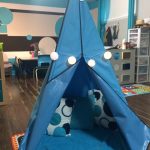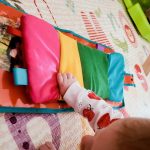
By Nathalie Lizé
As early childhood professionals, we understand the importance of providing the groups we care for, a place to retreat when needed. However, we cannot speak of calming down and giving kids a place to relax without understanding what is really going on in their heads.
The developing brain of a preschool child is still immature and dealing with emotions is complex for them. According to neuroscience, the neurological capacity of young children to control their moods is quite limited. It specifies that, confronted with intense or negative feelings, it is the center of emotions ( the reptilian Brain and limbic system), which takes over and this leads to reactions that adults might consider excessive. Neuroscience also specifies that all through childhood, children do not have much control over the intensity of their moods. As the part of their brain that allows them to take a step back is not fully matured (neocortex), sadness, anger, fear and even joy can be experienced particularly strongly. This is why sometimes they start crying, screaming, protesting or have problems calming down.
When this happens, it is up to adults to help children develop ways to return to their original state and learn to deal with these emotional outbursts. Considering that it is difficult for them to manage to control themselves, as a significant adult, it is important to welcome what they feel and to accompany them with kindness. However, despite all of our heartwarming words and hugs they might still need to be alone with themselves. So, a quiet corner well-placed and well-thought-out can become a precious ally to your interventions.
Use it positively
As it is a place to feel safe and be alone in peace, present it positively. Since the objective is well-being, it is important not to turn it into a negative or a punitive corner. First, find a location where it is possible to be isolated and make it comfortable. A tent with a few cushions, a teepee like the one by Natis Design
a small Floor mattress in a quiet corner of your daycare or even an under cabinet with a blanket as a door will do the job. So, when kids show first signs of sadness, anger or overexcitement, they can go there to feel better.
Use precise words that describe and explain the expected behaviors. Phrases like calm down or don’t be excited, are rather meaningless to a child. Clearly state the actions you want them to do.
Use a problem solving board to support your interventions. This tool should allow children to identify emotions quickly, like when using emotion charts. To facilitate appeasement, concrete solutions must also be illustrated. Complete with images indicating the appropriate behavior for example: a child reading a book, manipulating a ball or listening to a story with headphones on.
Present it to the group when the general mood is good. It can also be fun to do scenarios where you are the angry, sad or excited child. While playing, you demonstrate how to use the board and what to do in the calm down corner. This way of doing things gives children a clear picture, a kind of instruction’s manual.
Here is an example of calming cards to create by yourself.
https://pin.it/3Xm3IWp
If you prefer, there is also the feeling thermometer which is interesting.
https://pin.it/3l4Pa0X
To create calm down boards, consult pinterest, It is full of good ideas.
Several books can also help support your interventions. My favorite is
The Color Monster, a book about emotions”, by Anna Llenas, published by Little, Brown Books for Young Reader.
The children from 2 to 7 will love this story. It is funny and easy to understand.
Not just for angry kids
The calm down corner is very useful and even necessary to help angry or upset children. However, it can also become essential for those who need to be alone or who need to lower their level of excitement. To have a moment of respite or to get away from the hustle of the group, allow the children to be alone, on the quiet corner without friends.
-If you offer them different types of books to look at, out of sight of others they Will meet their need for temporary solitude.
-In order for them to be able to listen to music or stories, put on a radio with headphones. Children will certainly appreciate it.
-Add a light projector
-Provide them with various manipulation toys like Soft toys. Squeezing is a great way to self-regulate and even reduce anxiety. Anti-stress balls, gel balls, luminous balls, small hourglasses, objects that turn, things to squeeze or crush are to be preferred.
-Create stress balls with rubber balloons in which you will drop sand. Then tie a solid knot to close it and you’re done.
-Bottles in which you can put water, oil, pebbles, rice, colored beads and sparkles also helps.
-You can leave a weighted animal available that the children can put on their knees or shoulders to relax or even multi-textured products like the multi-textures and photos album from Natis design.
If you welcome children with special needs in your preschool classes, you will benefit more from having a quiet corner. As these children are easily stimulated by light, noise, movement, contact with others. it becomes necessary for them to have such a place to go when émotions get mixed up and complicated.
Learning to manage emotions, a gift for the future
Whatever the reason why children need solitude, your quiet corner will be a perfect option. Combined with patience and the proper tools, the benevolent use of this place will bring some harmony to your group. As educators, we are guides for the little ones. By supporting them in understanding what they are feeling, we thereby facilitate our work. By allowing them to understand the importance of managing their emotions properly, we are helping them for the future. Because, as you surely know, learning to develop a healthy management of our emotions from childhood increases our chances of having balanced relationships in adulthood. Providing a quiet corner for your group today is like a gift offered, so these young people will be better citizens tomorrow.
Hope you have fun creating your calm down corner
Nathalie Lizé
Early Childhood educator & coach




